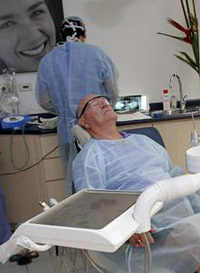
|  |  |  Health & Beauty | October 2009 Health & Beauty | October 2009  
Leaving the Country for Healthcare: Patients Save Money Outside US
 Kim Lamb Gregory - venturacountystar.com Kim Lamb Gregory - venturacountystar.com
go to original
October 02, 2009


 | | Dr. Luis Obando prepares to perform a root canal on Bill Jones of Dallas in San Jose, Costa Rica. (AP/Kent Gilbert) |  |
Robyn Collins’ primary income is from cleaning houses, so when she needed extensive dental surgery, the Ventura woman knew she wouldn’t be able to afford the part her insurance didn’t cover. So she became one of the hundreds of thousands of Americans who chose to get their surgery in another country. Collins parked her car across the border from Tijuana, Mexico, walked over the bridge, and took a cab to Washington Dental’s Tijuana office.

“I ended up with a root canal, two bridges and a tooth pulled,” she said. “It’s not for sissies. They don’t speak English. They don’t pamper you like they do in America.”

But it was much less expensive. Collins, 50, said she paid about a third of the quote given to her in the U.S., which was upward of $5,000.

She said she was pretty happy with the work; she got Novocain and a painkiller.

The number of Americans getting their health or dental care out of the country is increasing. According to a 2008 study conducted by the Deloitte Center for Health Solutions, 750,000 Americans traveled to a foreign country for medical and/or dental services in 2007, the last year for which the center has hard numbers. That number is projected to soar to 1.6 million by 2010. Deloitte is at nonpartisan think tank for the healthcare industry.

The buzzword in the industry describing this practice is “medical tourism.”

Argument for healthcare reform

Robert Hacker, California regional director for Facilities and Construction Services, Providence Health & Services, believes the rising trend in medical travel is an argument for a public health option in healthcare reform, which he said would control medical costs.

Hacker said the outsourcing of medical care will continue unless the U.S. figures some way to tame medical costs.

“It is important to note that in the U.S., particularly, insurance and administrative costs take up much of the healthcare budget,” he said.

Chuck Rosen, chief executive officer of CPR Insurance and Financial Services in Simi Valley, says that’s not true, that out of every $100 paid in insurance, no more than $15 goes to administrative costs.

Rosen said he agrees healthcare costs need to be controlled but disagrees that a public option is the way to do it. The fact that people are going out of the country for care shows a need to cut costs but also shows how well capitalism works. Somebody marketed global tourism; it was successful; people responded, he said.

“That’s an example of people seeing there is some profitability in that innovation,” Rosen said.

In fact, at least one U.S. insurance company is experimenting with covering some overseas surgery. In January, Anthem Blue Cross and Blue Shield of Wisconsin launched a pilot program in conjunction with Serigraph Inc., described on its Web site as one of the largest specialty printers in the world with employees in the U.S., Mexico, and Asia.

The pilot program will allow members to get covered care for certain procedures such as joint replacement and back surgery in accredited hospitals in India. A member who chooses this option will get a case manager who will make travel arrangements for the patient and a companion as well as postoperative care in the U.S. All of it will be covered.

A changing demographic

The author of a 2008 book on medical tourism said price is the number one reason Americans leave the country for healthcare. Rising medical care costs have also changed the demographics of the medical traveler.

“Medical travel used to be for the Beverly Hills, Chevy Chase set,” said Josef Woodman, author of Patients Beyond Borders: Everybody’s Guide to Affordable, World-class Medical Tourism, published by Healthy Travel. “We’re talking about a very different type of medical traveler now.”

Elective surgeries — like cosmetic surgeries — are still the most common medical procedures performed abroad, which aren’t covered by insurance.

But today’s medical travelers also include more uninsured or underinsured people going overseas for medically necessary surgery, even if it’s covered by insurance, said Deloitte Executive Director Paul Keckley.

“There are a number of things your insurance would cover per se, but it falls under your deductible, so you’re paying out of pocket,” Keckley said.

Statistics from Commonwealth Fund, a private foundation that promotes better access to high quality healthcare, showed in 2007 that 72 million working age Americans were paying off medical debt, up 7 percent from 2005.

Baby boomers are among those crossing the border, Woodman said, because of rising medical debt and deductibles.

“With boomers, it’s ‘Do I send my kid to college or do I get my hip replaced?’ ”

Woodman, who used to run a publishing company, started researching his book in 2004, when his father announced he was going to Puerto Vallarta, Mexico, for dental surgery.

Curious, Woodman traveled around the world, visiting 100 medical facilities in 14 countries.

He learned the medical tourism industry was booming, launching travel companies, jobs, trade associations and related industries.

The Medical Tourism Association formed in 2007 as a trade organization for international healthcare providers.

The association’s chief operating officer, Renee Marie Stephano, said Costa Rica, Mexico and India are among the more popular destinations, but there are plenty of others, including Brazil, Singapore, Thailand, Korea and Jordan.

One of the job descriptions that has risen out of medical tourism is that of a “medical facilitator,” whose job it is to work on-site with foreign visitors seeking medical care. A facilitator’s job is to arrange all the details surrounding each patient’s visit, which can include interpreters, travel packages and surgical packages.

Pamela Thompson, originally from Visalia, works as a medical facilitator in Puerto Vallarta.

Thompson said she sees about 500 Canadian or American patients every month, arranging surgical packages that can include everything from hotels to translation services.

Thompson contracts with 26 physicians who work in the six hospitals in the region. Thompson said the most popular types of surgery are cosmetic, bariatric and orthopedic, with about 70 percent of surgeries being cosmetic.

On average, procedures run 25 percent to 30 percent less in Puerto Vallarta than in the U.S., she said.

Quality control

Local physicians say there are excellent physicians in other countries, but all urged caution.

“It’s hard to get follow-up, and it’s hard to get problems fixed afterward,” said Ventura cosmetic surgeon Dr. Samuel Bern. “Then, I think the standards for anesthetic safety and sterility are lower in some of these countries. There could be a higher incidence of infection and complications.”

Thousand Oaks cosmetic surgeon Dr. Kouros Azar said a qualified doctor is just one component of good care.

Among other concerns are the cleanliness of the hospital, the standards for the blood supply, the training standards for the support staff and the purity of the drugs used, especially intravenous drugs, he said.

Woodman recommends going to a hospital accredited by the international arm of the Joint Commission on Accreditation of Healthcare Organizations called the Joint Commission International. The JCI accredited its first hospital in São Paulo, Brazil, in 1999. Now it has accredited 266 organizations in 38 countries.

If something does go wrong with surgery in a foreign country, a patient often returns to a U.S. surgeon to fix it.

Thousand Oaks cosmetic surgeon Dr. Chris Costanzo recently fixed a tummy tuck done in Mexico City and breast implants from Argentina.

One “big dark hole,” said Paul vanOstenberg, senior executive director for International Accreditation and Standards, is legal recourse. If something goes wrong, chances are, you can’t sue.

Patients sign waivers, Thompson said, even though the doctors she works with in Puerto Vallarta do carry malpractice insurance.

Medical Tourism Association’s Stephano said the best advice for medical travelers is to do your homework.

“Get documentation and all the information you’re looking for in your native language,” she said. |

 |
|  |



